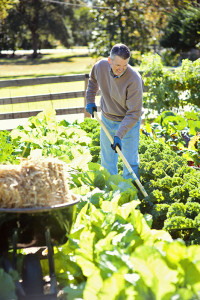
By Melinda Myers
Increase your harvest without increasing the size of your garden or workload. All you need is a bit of intensive planting, along with some low maintenance techniques.
Invest some time upfront to prepare the garden soil. This will save you time throughout the growing season. Add several inches of organic matter and a slow release fertilizer into the top 8 to 12 inches of soil. The organic matter improves drainage in clay soils and increases moisture retention in sandy soils. The slow release fertilizer feeds the plants for several months, reducing the number of applications needed. You’ll have healthier plants that are better able to fend off pests and outcompete the weeds.
Match the plants with the right growing conditions. Tomatoes, peppers, and other vegetables that produce fruit need full sun. Leafy crops like lettuce are more tolerant of shade. Check plant tags and seed packets for planting details or download a free gardening app, like Homegrown with Bonnie Plants, for plant information, maintenance tips, weather reports, and more.
Plant seeds and transplants in blocks with fewer pathways. Give each plant enough room to grow to its full size. Your rows will be closer together with just enough paths for weeding, watering, and harvesting. You will be growing more plants and pulling fewer weeds with this strategy.
Interplant to further maximize your planting space. Plant short-season vegetables like lettuce and radishes in between properly spaced longer-season vegetables like broccoli and tomatoes. By the time the longer-season plants start filling the space, the shorter season plantings will be ready to harvest. You’ll be pulling radishes or cutting lettuce instead of weeds. Plus, you’ll harvest two crops from one row.
Plant successive crops throughout the growing season. Plant cool weather vegetables like spinach, radishes, and lettuce in spring. Once these are harvested, replace with warm weather vegetables like beans, tomatoes, or cucumbers. Finish off the season by filling any voids with a fall crop of cool weather vegetables.
Go vertical to save space, reduce disease, and make harvesting easier. Growing vine crops on supports lifts the fruit off the ground and increases the amount of light and airflow the plants receive, reducing the risk of disease. Plus, you’ll do less bending when it’s time to harvest.
Mulch the garden with pine straw/evergreen needles, shredded leaves, or other organic matter. These materials suppress the weeds, conserve moisture and add organic matter to the soil as they decompose. You’ll have fewer weeds to pull and not have to water as often.
Save time and water with the help of soaker hoses or drip irrigation. These systems apply the water directly to the soil where it is needed. Less water is lost to overspray, evaporation, and runoff. They also reduce the risk and spread of disease by preventing water from settling on the leaves of the plants.
Try a few or all of these strategies this season for an abundant harvest without a lot of extra work.
Melinda Myers has over 30 years of gardening experience has written over 20 gardening books, including Small Space Gardening and the Midwest Gardener’s Handbook. She hosts The Great Courses “How to Grow Anything: Food Gardening For Everyone” DVD set and the nationally syndicated Melinda’s Garden Moment TV & radio segments. Myers is a columnist and contributing editor for Birds & Blooms magazine and was commissioned by Bonnie Plants for her expertise to write this article.





I loved the article, thanks bazil’s.
When you said, “Go vertical to save space,” I was thinking my hergle-culture berms. LOL I did make an initial attempt at a decorative walking arch. Luckily the melons didn’t germiinate as I am still struggling a bit with the “great weight/supporting phase” on the project.
on your comment:
“Mulch the garden with pine straw/evergreen needles, shredded leaves, or other organic matter. ”
I would append that for “those of limited quantities of available material to plan a variation of your mixtures to match the acidic variation of the of what you have available.” Since this material will still be decomposing after this crop is harvested the idea becomes, “replace plus, for what you intend to harvest out.” That way you are always adding to the soil for future crops.
One additional thing about the drip/soakers, the surface remains drier, less mold for attacking plants or bugs to live off of, while you are actually moistening the soil, direct to the roots. ( If you water in a smaller spot, there will be less evaporation on the surface while capillary action within the soil will distribute the moisture. )